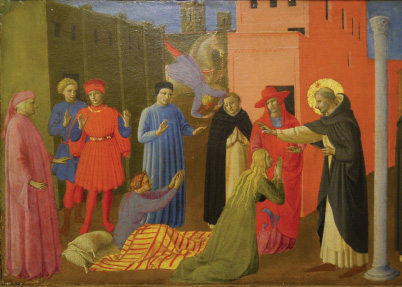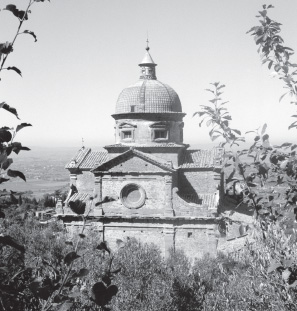![]()
THE old road south from Arezzo follows the line below the hills that flank the Val di Chiana. This passes the town of Castiglion Fiorentino and the spectacular castle of Montecchio Vesponi, once owned by the English condottiero Sir John Hawkwood. Then the ancient city of Cortona comes into view. The main road twists up the hillside, passing the greatest of the Cortonese villas, built for Cardinal Silvio Passerini. It is no longer possible to drive through the Porta San Domenico, so the motorist should follow round the town walls to the left, your reward a splendid section of Etruscan polygonal masonry. A short walk from the Porta Colonia leads to the Piazza del Duomo.
The cathedral itself is not particularly remarkable, but the Museo Diocesano in the former church of the Gesù opposite most certainly is. Among Tuscan museums of the kind, only that at Asciano, admittedly much smaller, boasts so high a proportion of masterpieces. Fra Angelico’s Annunciation from the church of San Domenico is indisputably the finest of his several altarpieces of the subject. The Angel is inexorable in his message, the Virgin perfect in her submission to this. The predella too is of the utmost refinement; in the Visitation the painter shows the view from the town, with hills to the left, the level valley on the right and in the distance Lake Trasimene. The frate’s own monastery was associated with San Domenico, for which he also supplied a polyptych, which happily survives with its predella. Cortona had for over a century turned to Sienese painters, including Pietro Lorenzetti. This tradition was represented by the polyptych of the mid-1430s, also from San Domenico, by Sassetta. He was well aware of the challenge posed by Fra Angelico and rose to it with his innate poetic conviction.

Museo Diocesano: Fra Angelico, Saint Dominic raising Napoleone Orsini, predella panel (detail).
The Cortonese could claim no artistic school of their own. The sculptor of the font by the Annunciation, which used to be attributed to the wonderfully named Ciuccio di Nuccio, would hardly have been employable in Florence. But the town can boast one painter of genius, Luca Signorelli. Downstairs is a room with a significant group of late altarpieces by him, the finest his Deposition of 1502. Nearby is the remarkable cope with embroidery designed in 1525 for Cardinal Passerini by no less an artist than Andrea del Sarto. The frescoes in the lower church were an early project of the Aretine Giorgio Vasari, who in his childhood had known Signorelli.
There is much to see in the town. The Accademia Etrusca in its eighteenth-century heyday received self-portraits from Zoffany and Northcote. Although Fra Angelico’s altarpieces have gone, there is a frescoed lunette by him at San Domenico. And the church contains an exceptionally complete late Gothic altarpiece by Lorenzo di Niccolò – supplied second-hand by the Medici – as well as a masterpiece of Signorelli’s early collaborator, Bartolomeo della Gatta. The Assumption of the Virgin, like the frescoed Saint Jerome of the cathedral at Arezzo, shows that Bartolomeo came close to being a painter of genius.

Giorgio Vasari, Santa Maria Nuova.
The energetic can walk uphill, passing several small palaces and a good bust of one of the Tomassoni, for porticoed San Niccolò with its Dead Christ with Saints by Signorelli, simple yet of power. Higher still is the ugly sanctuary of Santa Margarita of Cortona, redeemed by the saint’s sculptured tomb of 1362 and by a late masterpiece of the Sienese Counter-Reformation, Francesco Vanni’s visionary Immaculate Conception. At the apex of the hill is the well-named Castel del Girifalco (gyrfalcon).
Below the walls of the town, respectively to the south and the north, are two domed churches, Santa Maria del Calcinaio (lime-worker) and Santa Maria Nuova. The former, of Latin cross plan, was begun in 1485, apparently to the design of that most versatile of Sienese artists, Francesco di Giorgio; with its crumbling pietra serena enrichments, this exemplifies the controlled classicism of the late Quattrocento. Santa Maria Nuova, by contrast, is centrally planned. The design was due to Vasari, but the executant mason was a local man, Cristoforo Infregliati. Built in 1550–4, the church deserves to be open more regularly than it is. Foundations of the kind mushroomed in the area during the Renaissance, as towns competed to commemorate miraculous visions like that of the Cortonese lime-worker who saw an image of the Virgin. Externally by far the most impressive is the Bramantesque Santa Maria della Consolazione below Todi, but this, alas, was only completed internally after a long interval. Sangallo’s San Biagio outside Montepulciano is much larger than either of the miracle churches at Cortona, yet lacks their charm.